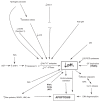An integral approach to the etiopathogenesis of human neurodegenerative diseases (HNDDs) and cancer. Possible therapeutic consequences within the frame of the trophic factor withdrawal syndrome (TFWS)
- PMID: 19337452
- PMCID: PMC2646641
- DOI: 10.2147/ndt.s3800
An integral approach to the etiopathogenesis of human neurodegenerative diseases (HNDDs) and cancer. Possible therapeutic consequences within the frame of the trophic factor withdrawal syndrome (TFWS)
Abstract
A novel and integral approach to the understanding of human neurodegenerative diseases (HNDDs) and cancer based upon the disruption of the intracellular dynamics of the hydrogen ion (H(+)) and its physiopathology, is advanced. From an etiopathological perspective, the activity and/or deficiency of different growth factors (GFs) in these pathologies are studied, and their relationships to intracellular acid-base homeostasis reviewed. Growth and trophic factor withdrawal in HNDDs indicate the need to further investigate the potential utilization of certain GFs in the treatment of Alzheimer disease and other neurodegenerative diseases. Platelet abnormalities and the therapeutic potential of platelet-derived growth factors in these pathologies, either through platelet transfusions or other clinical methods, are considered. Finally, the etiopathogenic mechanisms of apoptosis and antiapoptosis in HNDDs and cancer are viewed as opposite biochemical and biological disorders of cellular acid-base balance and their secondary effects on intracellular signaling pathways and aberrant cell metabolism are considered in the light of the both the seminal and most recent data available. The "trophic factor withdrawal syndrome" is described for the first time in English-speaking medical literature, as well as a Darwinian-like interpretation of cellular behavior related to specific and nonspecific aspects of cell biology.
Keywords: Alzheimer’s Disease; antiapoptosis; apoptosis; cancer; etiopathogenesis and treatment; human neurodegenerative diseases; intracellular acid-base homeostasis; neurodegenerative diseases and growth factors.
Figures

Similar articles
-
Hydrogen Ion Dynamics as the Fundamental Link between Neurodegenerative Diseases and Cancer: Its Application to the Therapeutics of Neurodegenerative Diseases with Special Emphasis on Multiple Sclerosis.Int J Mol Sci. 2022 Feb 23;23(5):2454. doi: 10.3390/ijms23052454. Int J Mol Sci. 2022. PMID: 35269597 Free PMC article. Review.
-
Growth and trophic factors, pH and the Na+/H+ exchanger in Alzheimer's disease, other neurodegenerative diseases and cancer: new therapeutic possibilities and potential dangers.Curr Alzheimer Res. 2007 Feb;4(1):53-65. doi: 10.2174/156720507779939841. Curr Alzheimer Res. 2007. PMID: 17316166 Review.
-
Cellular acidification as a new approach to cancer treatment and to the understanding and therapeutics of neurodegenerative diseases.Semin Cancer Biol. 2017 Apr;43:157-179. doi: 10.1016/j.semcancer.2017.02.003. Epub 2017 Feb 11. Semin Cancer Biol. 2017. PMID: 28193528 Review.
-
Mitochondrial biogenesis: pharmacological approaches.Curr Pharm Des. 2014;20(35):5507-9. doi: 10.2174/138161282035140911142118. Curr Pharm Des. 2014. PMID: 24606795
-
Growth Factors and Their Application in the Therapy of Hereditary Neurodegenerative Diseases.Biomedicines. 2024 Aug 20;12(8):1906. doi: 10.3390/biomedicines12081906. Biomedicines. 2024. PMID: 39200370 Free PMC article. Review.
Cited by
-
Cariporide and other new and powerful NHE1 inhibitors as potentially selective anticancer drugs--an integral molecular/biochemical/metabolic/clinical approach after one hundred years of cancer research.J Transl Med. 2013 Nov 6;11:282. doi: 10.1186/1479-5876-11-282. J Transl Med. 2013. PMID: 24195657 Free PMC article. Review.
-
Hydrogen Ion Dynamics of Cancer and a New Molecular, Biochemical and Metabolic Approach to the Etiopathogenesis and Treatment of Brain Malignancies.Int J Mol Sci. 2019 Sep 1;20(17):4278. doi: 10.3390/ijms20174278. Int J Mol Sci. 2019. PMID: 31480530 Free PMC article. Review.
-
Glycolysis, tumor metabolism, cancer growth and dissemination. A new pH-based etiopathogenic perspective and therapeutic approach to an old cancer question.Oncoscience. 2014 Dec 18;1(12):777-802. doi: 10.18632/oncoscience.109. eCollection 2014. Oncoscience. 2014. PMID: 25621294 Free PMC article.
-
Hydrogen Ion Dynamics as the Fundamental Link between Neurodegenerative Diseases and Cancer: Its Application to the Therapeutics of Neurodegenerative Diseases with Special Emphasis on Multiple Sclerosis.Int J Mol Sci. 2022 Feb 23;23(5):2454. doi: 10.3390/ijms23052454. Int J Mol Sci. 2022. PMID: 35269597 Free PMC article. Review.
-
Towards an Integral Therapeutic Protocol for Breast Cancer Based upon the New H+-Centered Anticancer Paradigm of the Late Post-Warburg Era.Int J Mol Sci. 2020 Oct 10;21(20):7475. doi: 10.3390/ijms21207475. Int J Mol Sci. 2020. PMID: 33050492 Free PMC article. Review.
References
-
- Alio JL, Colecha JR, Pastor S, et al. Symptomatic dry eye treatment with autologous platelet-rich plasma. Ophthalmic Res. 2007;39:124–9. - PubMed
-
- Anitua E, Andia I, Ardanza B, et al. Autologous platelets as a source of proteins for healing and tissue regeneration. Thromb Haemost. 2004;9:4–15. - PubMed
-
- Anitua E, Andia I, Sanchez M, et al. Autologous preparations rich in growth factors promote proliferation and induce VEGF and HGF production by human tendon cells in culture. J Orthop Res. 2005;23:281–6. - PubMed
-
- Anitua E, Sanchez M, Nurden AT, et al. Autologous fibrin matrices: a potential source of biological mediators that modulate tendon cell activities. J Biomed Mater Res. 2006;77:285–93. - PubMed
-
- Anitua E, Sanchez M, Nurden AT, et al. Reciprocal actions of platelet-secreted TGF-β1 on the production of VEGF and HGF by human tendon cells. Plastic Reconstruct Surg. 2007a;119:950–9. - PubMed
LinkOut - more resources
Full Text Sources
Other Literature Sources

